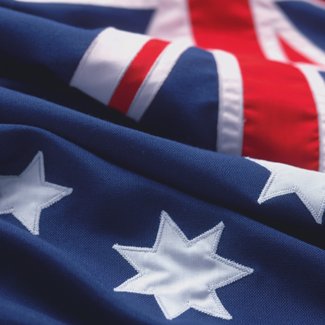On this day: Australia Day, 26 January

WHEN CAPTAIN ARTHUR PHILLIP unfurled the Union Jack in 1788, at an inlet of Sydney Harbour, there was little sense of what it would set in motion. This day, 26 January, saw the birth of a new colony; saw the first of many new waves of migration to these shores; and grimly changed the fate of one of the world’s oldest cultures.
What we now call Australia Day has been entitled, celebrated and received in countless different ways since the arrival of the First Fleet. Perceptions of this national day, and its position in our collective consciousness, are as varied as Australia’s cultural heritage.
“For some, Australia Day represents a ritual moment at the end of the summer – time for the last family holiday,” says Professor Andrew Jakubowicz, a sociologist at Sydney’s University of Technology.
Across the nation
On the 26th of January events are held that celebrate aspects of Australian life most dear to us. Informal events such as barbecues, beach cricket, fireworks, family meals – and even a countdown of the most popular songs on a government youth radio station – take place across the nation.
There are official events in every capital city. In Darwin, the Australian Ute Run showcases cars, people, utes and dogs dressed in Aussie getup. In Sydney, a fireworks spectacular takes place as well as the world’s oldest continuously held sailing regatta. In Melbourne, on the eve of Australia Day, top comedians gather annually to debate controversial topics.
In Canberra, the Prime Minister addresses the nation, a ceremony initiates thousands of new Australian citizens and awards are handed out for Australian of the Year, and the Order of Australia.
Earliest celebrants
The earliest celebrants of Australia Day were emancipists – ex-convicts and the sons of convicts – who found prosperity in this new land. An edition of the Sydney Gazette in 1817 records an ’emancipists’ dinner’ held to commemorate ‘Foundation Day’ or ‘Landing Day’ on 26 January 1817.
That same year, the colonies had been united under the name Australia, after a suggestion from the island’s circumnavigator, Matthew Flinders – the birth of Australia as a nation had begun.
Celebrations grew in prominence in 1818, on the 30th anniversary of the arrival of the First Fleet, when Governor Macquarie made the 26 January a public holiday and fired 30 guns in celebration.
The nation’s 50-year jubilee in 1838 saw the anniversary shift to an official annual public holiday, and was also the second year of the regatta which still takes place in Sydney on 26 January.
It wasn’t until 1946 that the name ‘Australia Day’ was adopted, and the ‘Australia Day Council’ was appointed to oversee its celebration.
Invasion Day
Though for many people Australia Day is a celebration, for some, particularly indigenous Australians, the mood is less jovial.
“There have been indigenous leaders that refer to Australia Day as Invasion Day,” says Andrew. “In their terms, and historically, [26 January] is not so much the beginning of Australia as we envisage it, but a reflection of a moment in political history when an imperial power laid claim to other people’s land.”
Lester-Irabinna Rigney, director of studies in indigenous education at Flinders University, SA, recalls attitudes to the 26 January anniversary from his youth. “I was raised on a mission at Point Pierce on South Australia’s Yorke Peninsula. Australia Day wasn’t celebrated much on the mission in that era of the ’60s and ’70s. In many ways it was a day to mourn.”
Attitudes to Australia Day are currently undergoing a process of adjustment – and not only among indigenous Australians. “It is important to realise that there are so many different versions of Australia,” says Lester-Irabinna. “Refugees have a version, indigenous people have a version… Australia Day causes us to stop and reflect on the version of Australia we have.”
He argues that some indigenous communities are starting to see the day as a symbol of hope for reconciliation and progress. “It’s a far more accurate reflection than in my day – we ignored it consciously, and tried to put it down in the dark recesses of our minds, not to be reminded of our wallowing dispossession.”
Changing reception
Andrew Jakubowicz agrees that attitudes aren’t what they used to be, particularly what he calls the newfound patriotism of white Australia. “The notion of the strong nationalist perspective wasn’t there when I was a student. During the Vietnam War period we were antagonistic to patriotism. That was seen as American, not Australian.”
Ethnic groups, on the whole, see Australia Day as an opportunity to reflect on the advantages that have come with their migration, he says. “Despite all the problems, like isolation and marginalisation at times, they realise that the opportunities for their kids are extraordinarily high, that the lifestyle is extremely good.”
The mixture of opinions offers us some food for thought says Lester-Irabinna:
“When we look at Australia from a diverse viewpoint, we have these fascinating views – some very seductive, warm and glowing, and others are bitter, angry, with dark colours…Australia Day is a day like no other, in which we ask all of our citizens to reflect on the Australia we have today, and project their wishes for the Australia we’d like in the future.”
READ MORE:
- Australian inventions that changed the world
- The origins of Australia Day
- 10 iconic Australian foods
- Top 10 classic Australian songs

